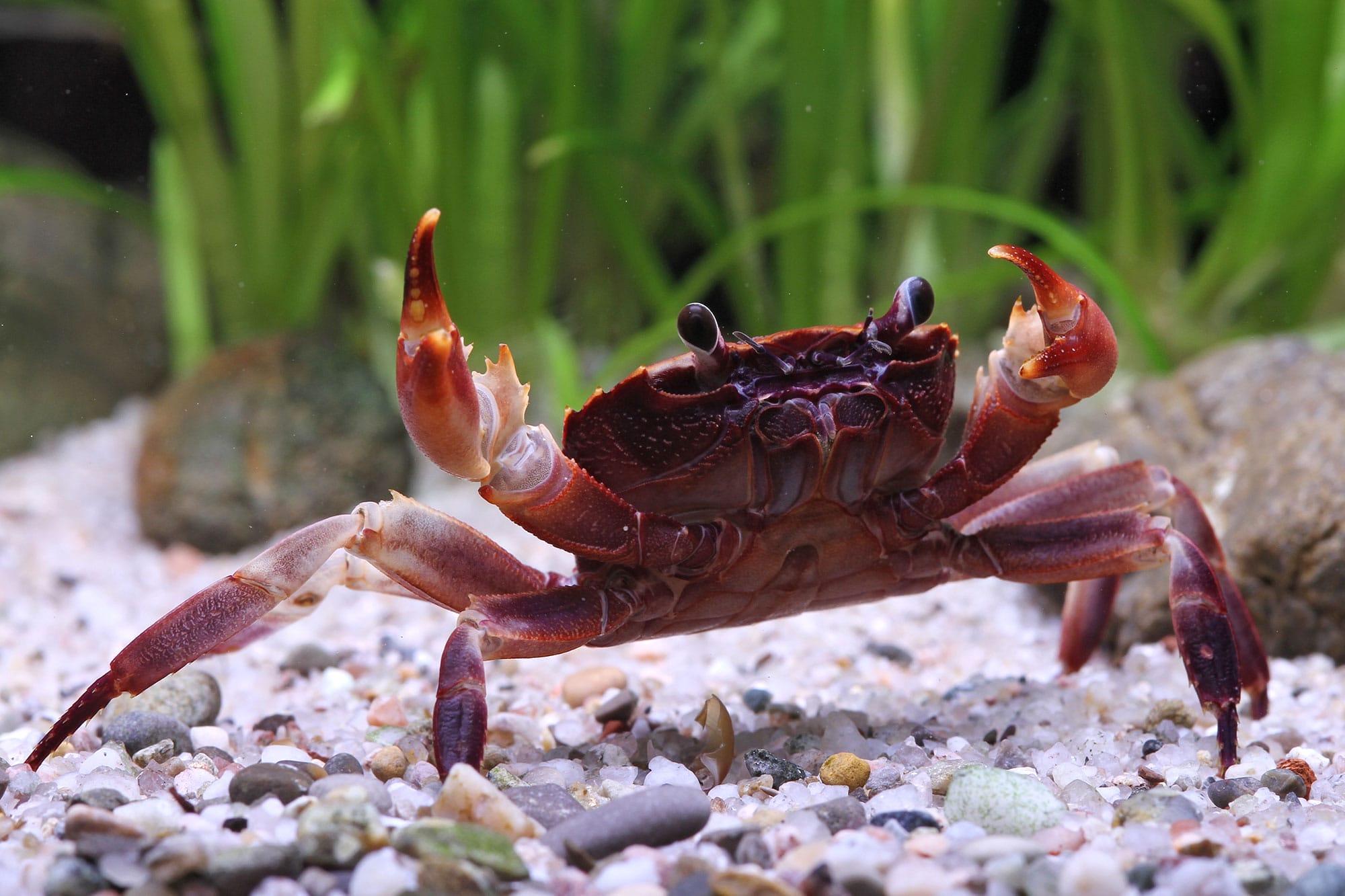
Blue Tiger Shrimp: Essential Care Tips
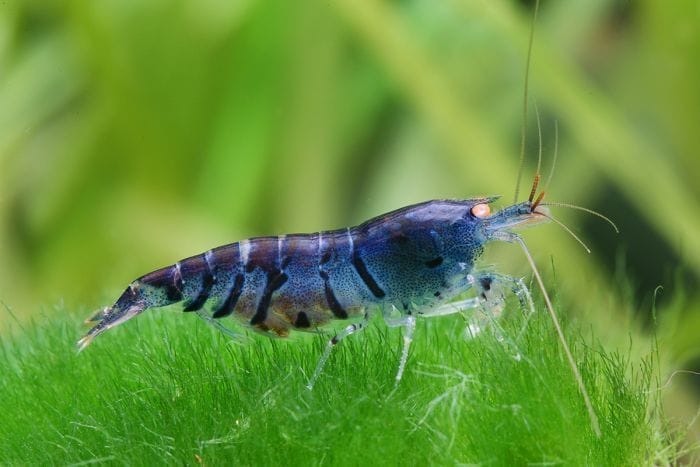
Are you a shrimp lover looking to add some color and vibrance to your aquarium? If yes, then Blue Tiger Shrimp might just be the perfect addition for you. These fascinating creatures are native to Southeast Asia and are known for their striking blue stripes and patterns.
In this blog post, we will give you an overview of Blue Tiger Shrimp, from their natural habitat to how to identify male and female shrimp. We will also provide care tips on ensuring healthy growth, preventing color loss, understanding their diet, breeding them, selecting tank mates, OEBT requirements, water quality parameters, filtration systems, molting frequency, and more. Join us as we dive deep into the world of these captivating creatures.
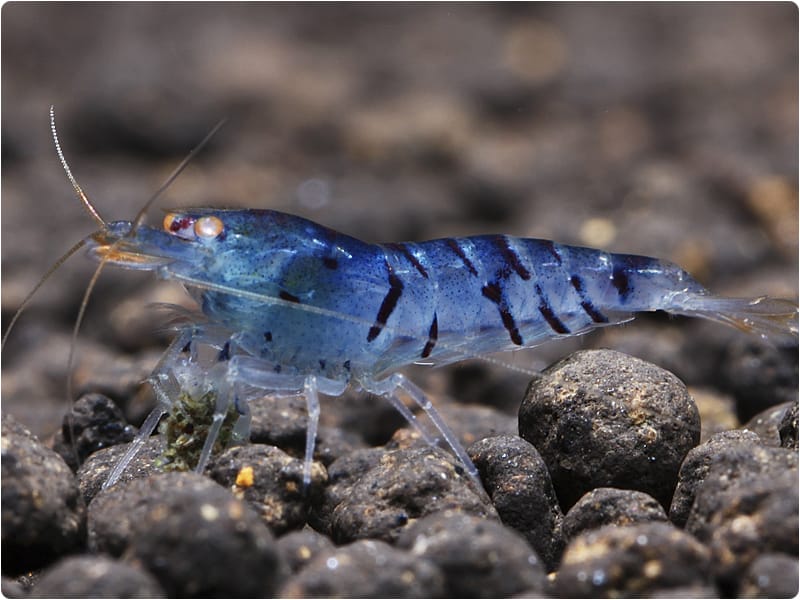
An Overview of Blue Tiger Shrimp
Blue tiger shrimp, belonging to the caridina species, are a stunning addition to any aquarium. They are known for their vibrant blue coloration and distinctive tiger stripes, making them a captivating sight in a well-established tank.
However, keeping these delicate creatures requires careful attention to water quality and tank mates. Adding aquarium plants for cover can create a stress-free environment where they can thrive.
One of the key considerations when keeping blue tiger shrimp is maintaining water conditions that mimic their natural habitat. This includes maintaining stable water parameters such as pH, temperature, and hardness.
Additionally, regular water changes and the use of high-quality filtration equipment can help keep the water clean and healthy for your shrimp.
Another important factor to keep in mind is choosing appropriate tank mates. Blue tiger shrimp are relatively small and peaceful creatures that do best in a community of similarly-sized, non-aggressive species.
It’s also essential to provide plenty of hiding places and cover with live aquarium plants like mosses or ferns. These plants not only offer cover but also add oxygen to the water and absorb nutrients that could lead to algae growth. Overall, with proper care and attention, blue tiger shrimp can make a beautiful addition to any freshwater aquarium.
The Natural Habitat of Blue Tiger Shrimp
Creating a suitable environment for blue tiger shrimp in freshwater habitats is essential for their survival. These shrimp prefer densely planted areas and higher pH levels, so it is recommended to replicate their natural habitat with Malaysian driftwood and live plants.
Additionally, providing indian almond leaves and a sponge filter can help the shrimp colony thrive in their new home. It is also important to ensure that there are plenty of hiding places available in the tank setup as this will make them feel more secure. By creating an environment that mimics their natural habitat, blue tiger shrimp are more likely to flourish in captivity.
Identifying Male and Female Blue Tiger Shrimp
Distinguishing between male and female blue tiger shrimp is a simple process that involves examining their body coloration. Females can be identified by their orange eye color, whereas males display a striking blue body color.
It is worth noting that the species’ common name refers to their beautiful blue coloration. Breeding these shrimp requires a thorough understanding of their physical characteristics, including body and eye coloration.
Similarly, other Neocaridina species like blue dream shrimp also exhibit unique male and female traits that are important to identify for effective breeding. These distinctions help shrimp breeders create healthy populations and maintain genetic diversity.
Understanding the differences between male and female shrimp is also crucial in preventing unwanted breeding and maintaining balanced aquarium ecosystems.
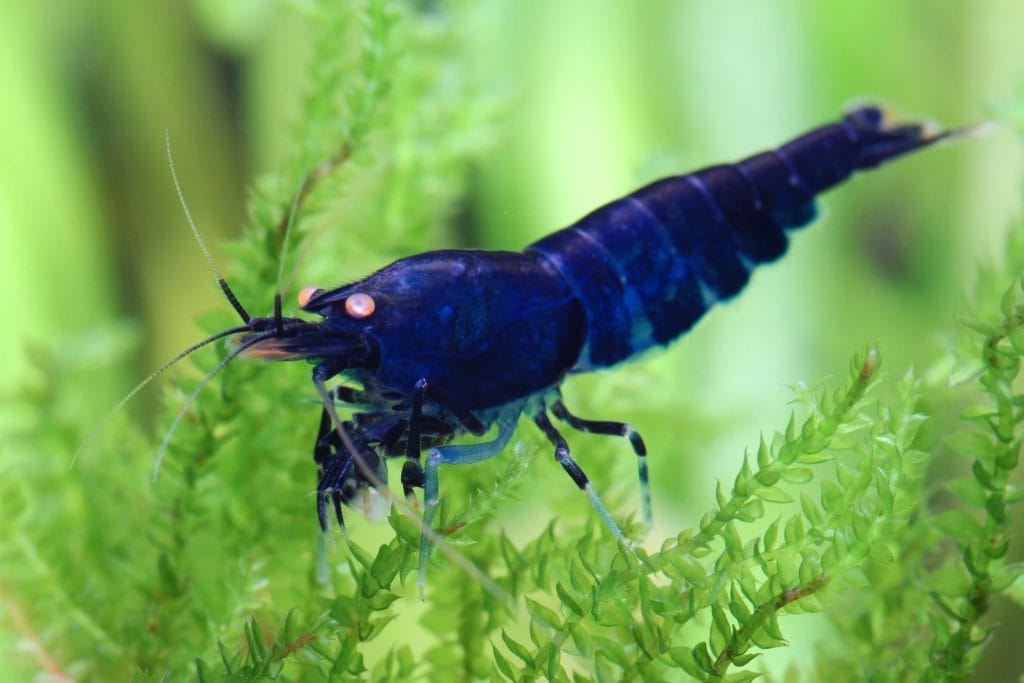
Care Tips for Blue Tiger Shrimp
Maintaining optimal water quality is crucial for the long-term health and well-being of blue tiger shrimp. To create an ideal home aquarium for these freshwater species, it is important to provide sufficient hiding places, live plants, and moss. In terms of nutrition, it is recommended to offer a balanced diet that includes algae wafers, mosquito larvae, and shrimp-specific food.
When selecting tank mates for blue tiger shrimp, it’s important to follow the general rule of coexistence that considers factors like compatibility, size, and behavior.
By providing a suitable environment and proper care for blue tiger shrimp, you can ensure their longevity and vibrant coloration in your aquarium.
Ensuring Healthy Growth
Blue tiger shrimp, like other shrimp species, require stable water parameters and a comfortable living environment to ensure healthy growth.
Providing hiding places and incorporating live plants, moss, and Indian almond leaves can help promote their well-being. Additionally, filtration is crucial for maintaining water quality, which can be achieved with a matten filter and sponge filter.
It’s important to note that the care requirements for blue tiger shrimp are similar to those of other shrimp species such as snowball shrimp, bee shrimp, and amano shrimp.
Proper care includes ensuring adequate food supply and avoiding overfeeding. Introducing a variety of foods such as algae wafers, blanched vegetables, and commercial shrimp pellets can provide essential nutrients for growth and development.
Regular water changes and monitoring water parameters such as pH level, temperature, ammonia, nitrate levels are crucial in maintaining a healthy aquatic environment for your blue tiger shrimp. By following these guidelines, you can ensure that your blue tiger shrimp thrive in their home environment.
Tips to Prevent Color Loss
Blue tiger shrimp are known for their vibrant and striking colors, and maintaining these colors requires proper care and attention. A balanced diet and suitable water conditions are crucial to preserving the bright hues of these shrimp.
Stress and poor water quality can lead to color fading, while dark blue tigers may benefit from being kept with orange-eyed blue tiger shrimp. Creating a well-maintained aquarium with java moss and Malaysian driftwood can also help preserve their deep blue hues.
To ensure that the colors of your blue tiger shrimp remain vibrant, it is essential to keep their environment clean and healthy. Promptly addressing any issues with water quality can prevent color loss.
Additionally, maintaining stable water parameters such as pH levels and temperature can also contribute to the overall health of your shrimp.
By prioritizing a balanced diet, suitable water conditions, and a well-maintained aquarium, you can enjoy the stunning colors of your blue tiger shrimp for years to come.
Understanding the Diet of Blue Tiger Shrimp
Blue tiger shrimp are known to feed on algae, biofilm, and organic matter that can be found in the aquarium. Providing them with additional sources of nutrition such as algae wafers, blanched vegetables, and shrimp pellets can help boost their vitality.
For baby blue tiger shrimp, nutrient-rich powdered shrimp food is ideal while orange-eyed blue tiger shrimp require a diverse diet that includes live plants and algae wafers. A well-balanced diet is crucial for the overall health and coloration of these shrimps.
It’s important to note that overfeeding can result in poor water quality which can negatively impact the health of the blue tiger shrimp. Therefore, it’s advisable to feed them small amounts at regular intervals throughout the day instead of one large feeding session.
In addition to providing adequate nutrition, maintaining a clean and healthy environment is also essential for their well-being. Regular water changes and filtration should be done to ensure optimal living conditions for these beautiful creatures.
Breeding Blue Tiger Shrimp
To create a favorable breeding environment for blue tiger shrimp, it is essential to optimize water parameters and provide hiding spaces. These shrimps are known to be excellent caretakers of their eggs, ensuring the survival of the next generation.
Introducing moss, java moss, and live plants in the breeding tank can provide ideal hiding spots for the baby shrimps. A successful breeding cycle can lead to the expansion of the blue tiger shrimp colony, creating a new home for future generations.
Additionally, maintaining consistent water conditions by monitoring pH levels, temperature, and water hardness can contribute significantly to the health and well-being of the shrimp population. It’s crucial to keep in mind that providing a conducive environment for breeding is key to increase the chances of success.
Selecting Tank Mates for Blue Tiger Shrimp
Choosing tank mates for blue tiger shrimp requires careful consideration of their water needs. It is advisable to select species that share similar water requirements to ensure harmonious cohabitation.
Red cherry shrimp, crystal red shrimp, and bee shrimp are suitable tank mates for blue tiger shrimp. When considering Neocaridina species like orange eye blue tiger shrimp, it’s best to opt for tank mates with a live arrival guarantee.
In addition to other types of shrimp, blue tiger shrimp aquariums can also house certain fish species such as dwarf shrimp, snowball shrimp, and blue dream shrimp.
However, it’s crucial to research the compatibility of any potential tank mate before introducing them into the aquarium to prevent any conflict or stress among the inhabitants.
OEBT requirements
To meet the needs of orange eye blue tiger shrimp (OEBT), it is vital to maintain stable water parameters and provide sufficient hiding spots. A proper OEBT tank setup should comprise of a sponge filter, java moss, and Malaysian driftwood.
Feeding these shrimp involves providing them with algae wafers, live plants, and enough hiding places to ensure their safety. Maintaining higher general hardness and pH levels is essential for their well-being.
Regular testing of water quality and performing routine water changes are crucial for maintaining an optimal environment for these shrimp to thrive in. By following these guidelines, you can create a comfortable habitat for your OEBT and ensure that they remain healthy and happy.
OEBT water quality
Keeping royal blue tiger shrimp in good health requires maintaining optimal water conditions. Consistent monitoring of pH and general hardness is essential, as well as ensuring proper filtration.
Providing hiding spots, live aquarium plants, and a sponge filter can also help improve water quality. Feeding algae wafers and mosquito larvae can provide additional nutrition to promote the long-term health of the shrimp.
It is important to note that water quality directly impacts the overall well-being of royal blue tiger shrimp, so taking measures to maintain optimal conditions should be a top priority for any shrimp keeper.
OEBT tankmates
When selecting tank mates for OEBT (Orange-Eyed Blue Tiger) shrimp, it’s crucial to consider compatibility and peaceful coexistence. Suitable companions include Cherry shrimp and Bee shrimp, as well as small fish species. It’s essential to have hiding places, driftwood, and live plants in the tank to create a stress-free environment.
It’s important to avoid adding any tank mates that may threaten the blue tiger shrimp colony, which ensures a harmonious aquarium environment. It is also worth noting that some species of snails like Nerite snails can coexist with OEBT shrimps without causing any harm. Providing a balanced diet and regular water changes can ensure the health and longevity of your OEBT shrimp and their tank mates.
Blue Tiger Shrimp and Taxonomy Problems
Accurate classification of species, particularly blue tiger shrimp, is essential to avoid confusion and provide appropriate care. Taxonomic issues can also impact availability and breeding of these shrimp.
Clear and precise taxonomy ensures genetic purity and prevents any confusion or misidentification in the future. It is important for aquarists and breeders to be aware of the taxonomy of their shrimp species to maintain healthy populations and prevent any potential problems related to misclassification.
Blue Tiger Male and Female Difference
Identifying the gender of blue tiger shrimp, particularly juveniles, can pose a challenge for breeders. Adult female shrimp are typically larger and have a more rounded body, whereas males are slimmer and smaller.
It is important to recognize these distinctions to ensure successful breeding. In addition to physical differences, observing their behavior can offer clues about their gender and provide insights into their needs.
Breeding blue tiger shrimp requires close attention to detail and careful observation of their physical characteristics and behaviors. One effective method of identifying gender is through examining the pleopods, which are located on the underside of the shrimp’s abdomen.
Females have shorter pleopods, while males have longer ones. Another way to distinguish between genders is by observing their behavior during mating. Males will chase females around the tank, while females will remain stationary or move slowly.
It is essential to be able to differentiate between male and female blue tiger shrimp when breeding them in captivity. This knowledge can help ensure that the ideal breeding conditions are provided, including proper diet and water temperature. With careful attention and observation, breeders can successfully cultivate a thriving colony of blue tiger shrimp.
The Shrimp Farm’s Water Parameters:
Creating a comfortable and healthy environment is vital for the well-being of blue tiger shrimp. Maintaining ideal water parameters such as temperature, pH, and hardness is crucial for their survival. Regularly testing water quality and making necessary adjustments can prevent overfeeding and neglecting water changes.
Decor and tank size also play a significant role in providing a comfortable environment for blue tiger shrimp. Ensuring adequate space and appropriate decor can significantly reduce stress levels for these aquatic creatures. A comfortable environment promotes healthy growth and breeding, leading to thriving royal blue tiger shrimp.
It’s essential to monitor the behavior of your blue tiger shrimp closely. This can help you identify any signs of stress or disease early on, allowing prompt action to be taken to ensure their wellbeing. Additionally, maintaining good water quality can also reduce the risk of disease outbreaks in your aquarium.
In conclusion, creating a healthy environment for blue tiger shrimp requires careful attention to water parameters, regular monitoring of behavior, appropriate decor, and tank size. By following these guidelines, you can promote the health and well-being of your royal blue tiger shrimp in their new home.
What type of filter should I use?
Selecting the right filter is crucial for a blue tiger shrimp tank. A sponge filter or matten filter are recommended options as they provide gentle filtration without harming the shrimp. The chosen filter should maintain water quality and keep the shrimp safe from being sucked in.
How often do Blue Tiger Shrimp molt?
Blue Tiger Shrimp molt periodically, shedding their exoskeleton to grow and regenerate body tissues. The frequency of molting depends on factors such as age, diet, and water quality.
Monitoring molting frequency helps assess the overall health of these shrimp. Providing a varied diet and stable water parameters supports their molting process.
What are the best tank mates for Blue Tiger Shrimp?
Choosing suitable tank mates is crucial for creating a harmonious aquarium environment for blue tiger shrimp. Compatible options include crystal red shrimp, orange eye blue tiger, amano shrimp, snowball shrimp, and cherry shrimp. It’s important to consider similar water parameter requirements and avoid aggressive fish or predatory shrimp species.
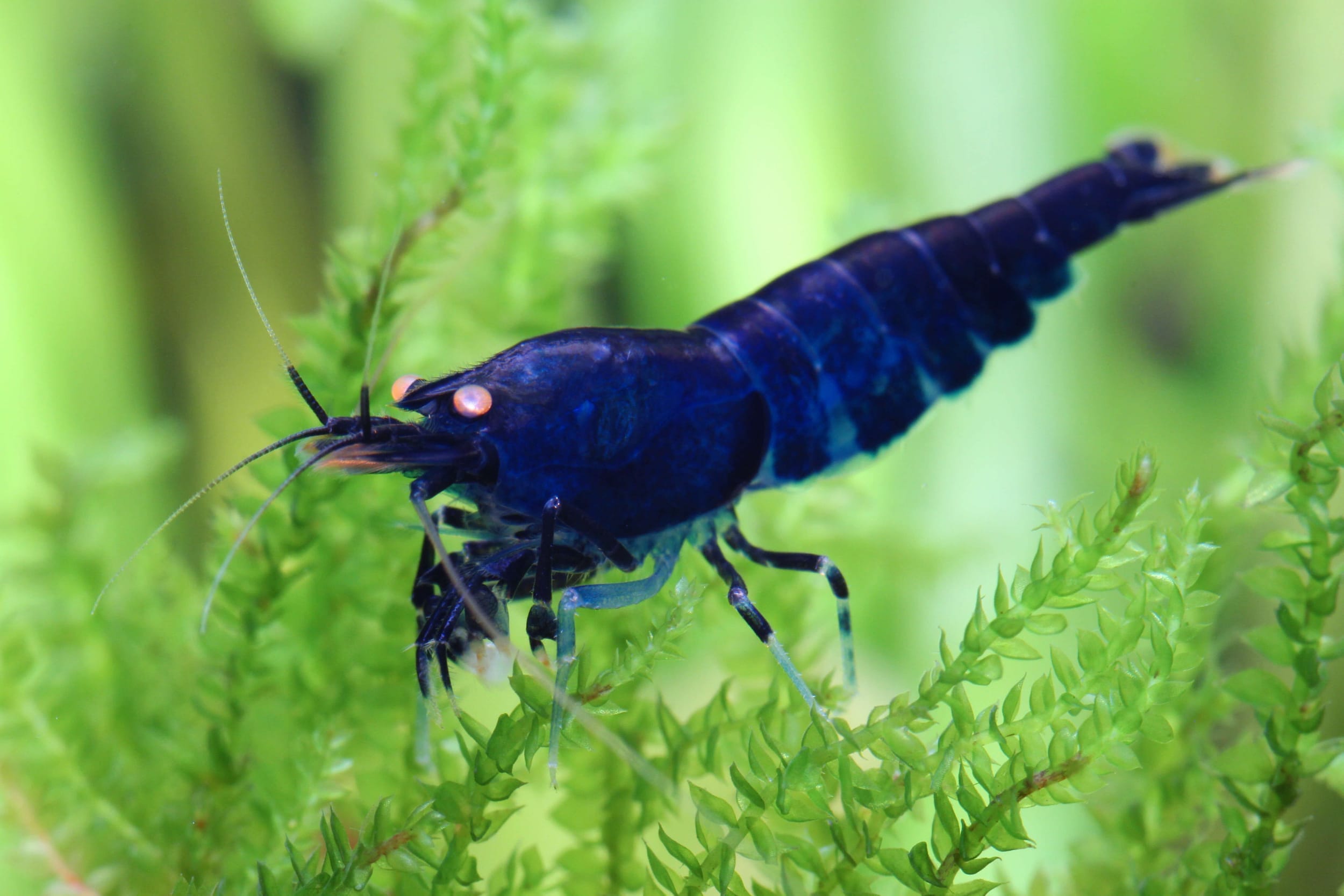
Conclusion
To ensure the optimal health and well-being of your Blue Tiger Shrimp, it is important to provide them with a suitable habitat and proper care. In their natural habitat, Blue Tiger Shrimp prefer densely planted aquariums with plenty of hiding spaces and a stable water parameter. It’s also crucial to maintain a clean environment and provide a balanced diet to promote their health and longevity. Additionally, understanding the specific requirements for green lace shrimp care is essential for ensuring the compatibility and well-being of these shrimp species if kept together in the same aquarium.
This includes maintaining water quality, providing a balanced diet, and understanding their breeding requirements. Additionally, it is crucial to select compatible tank mates and monitor their molting process.
Remember, Blue Tiger Shrimp are unique creatures that require specific conditions for their vibrant colors to thrive. By following these care tips and providing a conducive environment, you can enjoy the beauty of these fascinating shrimp in your aquarium. So, start implementing these tips today and create a thriving and visually stunning aquatic ecosystem.
FAQ
What are Blue Tiger Shrimp?
Blue Tiger Shrimp, also known as Caridina cantonensis “Blue Tiger,” are a selectively bred color variant of the Tiger Shrimp species. They are popular in the aquarium hobby due to their striking blue coloration and unique patterns on their exoskeleton.





